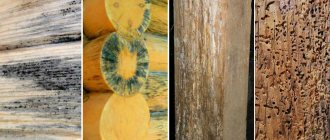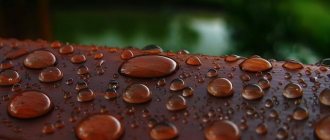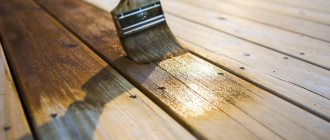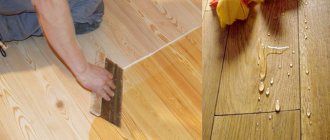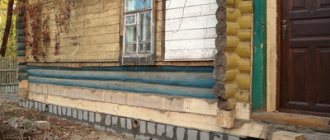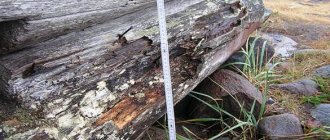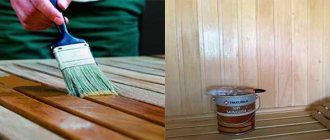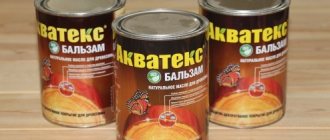Why is wood protection necessary?
The popularity of wood as an environmentally friendly material used in a variety of fields attracts both large manufacturers and ordinary users.
But wood has one feature that is worth considering. It is weakly resistant to moisture and decay, therefore it is subjected to special treatment. Before you start working with this natural material, you need to find out why wood needs protective manipulation by humans.
- Wood is a material that does not tolerate contact with moisture well. Most rocks begin to quickly become wet and deteriorate because of this, soon undergoing the process of rotting.
- Often wooden boards suffer from sudden temperature changes. They may begin to warp and become deformed.
- Wood can be seriously damaged by attacks from various wood parasites - beetles. They devour natural material, which is why its quality quickly decreases.
- Wood is also susceptible to fungal growths. The same mold, which often forms in conditions of high humidity, greatly spoils the quality and condition of the environmentally friendly material.
- The most dangerous thing for wood is contact with fire. The material not only ignites very easily, but also actively supports the flame.
To prevent all of the above factors from spoiling or completely destroying the natural material, specialized products are used that reliably protect the wood. After the treatment procedure, its performance characteristics and resistance to negative external influences increase sharply. The service life of wood increases noticeably, as does the service life of structures made from it.
Which trees cannot be whitewashed with lime?
Can all trees be whitewashed? Many gardeners believe that young plants should not be treated in this way, arguing that whitewashing will only harm them: it can burn the bark and prevent the trunk from “breathing” and growing in width. However, this is not quite true.
The bark of young trees is much thinner and more delicate than that of adult crops. This means that it may suffer more during the winter. But whitewashing with lime can also create certain problems. What to do in such a situation?
There are two solutions at once: firstly, you can halve the amount of lime in the whitewash solution, and secondly, the trees can be whitened with water-based or acrylic paint. Still, sunburn and frost damage will damage the young tree much more than whitewashing.
Latest articles for gardeners, gardeners and flower growers
Processing options
Protection of wood from fungus is carried out using a number of pre-conducted preventive measures. Choose one option or another based on the budget and operating conditions of the structure.
In construction stores there are different versions of such products available - both in the form of a solution and in the form of a paste. Protection should be applied not only to the wooden surface, but also to places in contact with the ground. The depth of impregnation is about one and a half meters. A solution of potassium dichromate (5%) or sulfuric acid (5%) is best suited. Novotex, Pinotex, Biokron and Biosept are antiseptics that are completely ready for use.
Only certain groups of antiseptics and impregnations are suitable for treating wood in the ground. Make sure that the product is moisture resistant, since underground the material is more susceptible to salt and moisture. It is necessary to cover with this preparation all surfaces of the structure that are exposed to precipitation.
Users often search for:
- Impregnations for wood
- How to paint a gazebo
- Wood protection for outdoor use
There are artificial and natural drying. The first option is carried out using petrolatum or storing wood in special chambers with elevated temperatures. The process occurs quickly: the time varies from one hour to several days, and the fungus dies under such conditions.
Natural drying is a more suitable option for doing it yourself. The wood is left under a canopy in the open air or stored in a well-ventilated area. The process takes a lot of time: from one week to several months, but this method does not require large material costs and guarantees reliable protection of the material.
A high foundation ensures a long service life of a wooden structure
How to whiten fruit trees?
- Garden whitewash. For whitewashing we traditionally use garden whitewash. The composition contains lime and binding components. It is sold in stores in 1 kg packaging. The price of such a package is about 40 rubles. We usually need 7-9 packages for the entire garden. This means that we spend about 350 rubles per appointment. Is it a bit expensive?
- Slaked lime fluff. We asked the price for ordinary lime. Slaked fluffy lime costs half as much in a garden store as special garden whitewash.
- Quicklime-boiler. But first you need to pay it off. At the same time, should it seethe and “boil”?
- Water-based paint (facade, for exterior use). Many summer residents doubt whether it is possible to use water-based emulsion to whitewash trees? Nevertheless, the authors of many reference books write that fruit trees can be whitened with lime or paint (water-based emulsion). Others express the opinion that the paint clogs the bark and does not allow the tree to fully “breathe.” Therefore, lime-based solutions are often used for whitewashing.
It is strictly not recommended to use bleach for whitewashing. Recommendations are in favor of freshly slaked lime (prepared from quicklime).
How does protection against moisture and rot work for wood?
It was already mentioned above that one of the reasons for the development of rot is high humidity. In some cases this is a consequence of precipitation, and in others it is a natural condition for a particular area (for example, coastal areas). In any case, the number one task to prevent rot is to protect the wood from external moisture. How to treat wood against rotting and moisture? To do this, you can purchase special preparations sold in hardware stores.
They are applied to the surface and make it water-repellent. Water falling on the walls of the house will immediately roll down, rather than remaining on the wood, gradually being absorbed and leading to the development of rot.
Some of them are applied comprehensively and have higher efficiency and durability. Others are applied one at a time - this is cheaper and takes less time. But their service life is noticeably shorter.
DIY marble tree
To make the interior sparkle with new colors, you can add original notes to it - stain the wood using a unique “marble” technique. First, buy the required amount of white acrylic paint and tint it in several selected shades. One of them must be basic.
Advice! It is better if the base is a light tone, for example, beige.
Imitation of marble with acrylic paints
Beige paint is poured into a flat container. Other shades of paint are poured into separate disposable cups - two or three tones that will suit the interior well and also be successfully combined with each other.
Each of the paints is poured in a thin stream directly onto the beige base to create an interesting design or an unusual abstract pattern - it will lie on a wooden blank. Afterwards, the pre-washed and dried wood product is carefully dipped into a container, allowing the paint to spread over the entire surface.
Round objects (for example, a wooden egg) are carefully rolled over the top layer of paint. The effect of marble wood is created in just a couple of seconds, and then you need to wait for the product to dry.
No. 4. Products for protecting wood from moisture
An increased level of humidity is the main enemy of wood, as it not only impairs performance, but also causes the appearance of mold and mildew. Treatment aimed at protecting against moisture begins with wood harvesting, and proper drying is of great importance. Even well-dried material will begin to absorb moisture over time, but in this parameter, different types of wood differ greatly. Larch, ash, pine, oak are more resistant to moisture, spruce, fir and beech are moderately resistant, and maple, birch and hornbeam are the most vulnerable. A number of tropical trees (kumaru, cousia, ipe, sisal) are practically not afraid of moisture and require only minimal protection.
The most important indicator of wood is intracellular moisture. For construction, you can use a material with a moisture content of 5-20%, and wood with a moisture content of 9-15% is suitable for truss structures and interior decoration, and 12-18% for exterior cladding.
To reduce the ability of wood to absorb moisture from the environment, i.e. To reduce its hygroscopicity, varnishes, oil impregnations and pastes are used, which are divided into two groups:
- the compositions that form a film on the surface are not durable enough, so the treatment will have to be repeated quite often;
- penetrating compounds are more durable and are able to penetrate the pores of wood; they are used to treat fences, window frames, house walls, and garden furniture.
As a rule, water repellents do not change the color of wood, and their effect is that drops of water simply roll off the surface without penetrating into the structure. A number of such products also have a frost-resistant effect.
How to treat wood with anti-rot impregnations?
It is best to apply water-repellent wood impregnation in dry and warm weather. Before applying the anti-moisture and rotting agent, the surfaces to be treated must be thoroughly cleaned, since contamination prevents normal adhesion and full penetration of the composition into the structure of the material.
To obtain the best effect, it is important to follow the proportions recommended by the manufacturer (if the product requires dilution).
When applying antiseptic compounds it is recommended:
- Apply water-based and other low-viscosity glazes with a spray gun, and thicker ones with a brush or roller.
- Take into account the drying time of the selected impregnation - it depends on the type of product.
- For internal use, choose environmentally friendly compounds that are absolutely safe for people and pets.
- Apply as many layers as recommended by the manufacturer.
- Repeat the treatment at the frequency specified in the instructions - weak saline solutions are applied annually, and heavy resinous solutions last for several years.
- Use the purchased azure strictly for its intended purpose.
- Familiarize yourself with the rules for using antiseptics and strictly follow them.
Recommendations for the selection and use of wood impregnations
Impregnation should provide reliable protection of wood from rotting, fungal infections and biological destruction, but at the same time be absolutely harmless to people, animals and the environment. These are the tools it offers. Impregnations from our catalog:
- have a natural plant composition, so they can be used for interior woodwork without the slightest risk;
- provide excellent results for a long period of time;
- easy to apply;
- penetrate deeply into the wood structure;
- form a reliable water-repellent barrier;
- improve the performance characteristics of the material and protect it from the negative influences of the external environment.
Preparation of whitewash solution
Let's take a look at several recipes for preparing whitewash.
The first recipe. Take:
- 1 kg of cow manure, slaked lime;
- 200 g of copper sulfate powder.
Dilute in 8 liters of water.
- 1 kg of fatty clay, cow dung;
- 2 kg of slaked lime;
- 250 g of copper sulfate powder.
Dilute in 10 liters of water.
- 2 kg slaked lime,
- 400 g copper sulfate powder,
- 400 g casein glue.
Dilute in 10 liters of water.
To avoid burning the wood shell, the proportions of the ingredients must be strictly observed. For young seedlings, dilute the mixture in double the volume of water (20 liters).
When diluting the composition, you should achieve the consistency of sour cream without lumps (pours easily, but not too liquid). Before use, the finished mixture must be kept for 2–3 hours.
All recipes are suitable for fruit-bearing trees, and a non-fruit-bearing garden can be treated with white acrylic paint. This coating can withstand all precipitation and does not require repainting.
Types of wood protection products
When choosing liquids to protect wood from moisture and rotting, consumers pay attention to its high efficiency. But, besides this, the substance must not be harmful to human health.
Most often, solutions that affect the durability of wood and can protect it from negative factors are quite dangerous.
It is absolutely necessary to ignore compounds containing tin and zinc compounds. These are the most toxic chemicals. Let's take a closer look at how to treat wood to protect it.
Decorative impregnation
Protecting wood from rot and water is the main task of moisture-resistant impregnation. The material processed with this composition is used to build baths, fences, basements, gazebos, etc. They are used both individually and in combination with bioprimers. The last substance must be treated with the boards before painting.
The essence of impregnation lies in its deep penetration into the structure of the wood and in this way clogging its pores. When treating wood with a solution, the penetration of moisture into the wood structure is limited. But besides this, impregnation colors wooden products and in this way gives them a noble appearance.
Oil based product
To prevent rotting, covering the boards with an oil-based product is necessary when using them externally. Protection of the board from rotting is ensured by the film formed after applying the product to the surface. Moreover, the resulting film on wood soaked in the solution does not allow water to be absorbed, and, therefore, prevents the fungus from penetrating into the wood structure.
The disadvantage of this product is the fact that a film forms on the surface, and it is not capable of protecting the tree from the effects of the fungus that already lives inside. The liquid composition of the impregnation is almost non-toxic, so it is used to cover wooden elements in houses where people live.
Water-based impregnation
Also, to protect wood from moisture, impregnation is used, which is well diluted in water. It is absolutely safe, there is no pungent odor when working with it, and it dries quickly. Water-soluble impregnations are used to prevent wood rotting and fungal penetration. Despite this, this composition is not recommended for use in rooms with high humidity. For example, when building a bathhouse, sauna or cellar.
The components of such solutions are boric acid, zinc chloride and sodium fluoride. They are better suited for wood, which is used in making furniture, making door openings, window slopes or frames.
Volatile based product
You can treat wood against rotting using means that have an easily volatile substance. The production of compositions is based on the addition of a certain substance to the coloring compositions, such as a solvent. Products of this type are not able to penetrate deeply into the structure of the wood, but at the same time they create a film whose strength is quite high.
Due to its volatility, the composition is best used for outdoor work, but it can also be used for interior wood processing indoors. The disadvantages of volatile agents include the long drying time of impregnating materials.
Four stages of whitewashing
Stage one: manual cleaning of branches and trunks
You will need cloth gardening gloves to complete this step. Under no circumstances should metal brushes or scrapers be used to clean bark. These tools will only damage it further, causing destruction instead of cleaning.
You can use a sharp sliver to clean cracks. It is necessary to remove wintering pests and carriers of tree diseases, and clear the trunk and lower branches of overgrown lichen and moss. All this must be burned.
Stage two: disinfectant treatment of bark
For disinfection, use 0.3 kg of copper sulfate powder diluted in 10 liters of water,
or iron sulfate (0.6 kg per 10 liters of water) You can use other copper-containing compounds, for example, “HOM”, “OXY-HOM”, “ABIGA-PIK”.
Spray the trunk and branches in such a way that the disinfectant composition does not flow down in streams. Usually a finely dispersed method , in which tiny drops of a disinfectant composition envelop the tree trunk, settling evenly on it. Such disinfection cannot be done often: the accumulated metal will adversely affect the condition of the plant.
There is another version of the disinfection solution, prepared from 2 kg of ash and a piece of laundry soap, which are diluted in 10 liters of hot water. This composition, when warm, is applied with a rag or a bunch of grass to the standard. Ash is a disinfectant for the plant and feeds it at the same time.
Stage three: sealing cracks in the bark
For this, special putties are used, which can be found in gardening stores or prepared independently. Here are some recipes:
- The mash is prepared from pure clay or mixed with lime, copper sulfate and manure. Dilute the mixture with water until the consistency of sour cream.
- You can prepare garden varnish yourself. To do this, melt 100 g of rosin and 200 g of real beeswax in turn; then they are mixed, 100 g of melted fat is added, poured into a container with cold water; taken out of the water and rolled into a ball. This putty can be stored for a very long time, slightly warming it up before application to ensure elasticity.
- “RANNET” putty already contains copper sulfate, so additional disinfection is not required. This paste perfectly treats wounds on wood; it can also be used to treat cut areas. Ready-made paste is available for sale.
Flowers are also susceptible to pests, and lavender is no exception. Read about insect pests of lavender in this article.
Most often, greenhouse thrips attacks plants such as tomatoes, cucumbers, and eggplants. Read about measures to combat this pest at https://stopvreditel.ru/rastenij/selxoz/teplichnyj-trips.html link.
No. 8. Sequence of application of protective agents
To ensure maximum safety of the wood, it is treated with protective agents in the following sequence:
- antiseptics at the stage of procurement and transportation, as well as after the construction of the structure, furniture, organization of finishing;
- treatment with fire retardants if necessary;
- treatment with moisture-repellent impregnations, which will also prevent the leaching of fire retardant and antiseptic;
- applying paints and varnishes with ultraviolet protection;
- sealing joints and seams using acrylic sealant is an important process that prevents moisture from penetrating into the wood.
Recommendations for application
Before protecting wood from moisture and rotting outdoors, it is important to study the recommendations for applying protective compounds. Compliance with the rules below will significantly improve the results of the work done:
If the wood is re-treated, the old layer should be carefully removed before applying the composition.
Depending on the condition of the surface layer of the wood, you can use a solvent, scraper or sandpaper. If work is carried out outdoors, it is important to monitor the temperature. The optimal range is from + 18 to + 25 degrees. If it is necessary to apply an additional layer of protective composition, this should be done no earlier than 3 to 5 hours after the first stage of work. It is recommended to apply a second layer of the composition to cracks and cuts, if any. Before treating wood from rotting and moisture, you need to thoroughly dry the material, preferably in the open air.
Before carrying out work, it is important to follow safety rules, namely, put on a respirator and gloves. Contact with skin and inhalation of vapors of protective compounds can cause serious harm to health.
Before work, be sure to wear gloves and a respiratorSource coffeesummit.org
No. 1. From what and in what cases should wood be protected?
Wood preservatives are aimed against various negative influences, and the choice depends on the conditions under which the material will be used. The main enemies of wood are:
- moisture (fog, rain, high indoor humidity). Wood is characterized by the ability to absorb moisture and swell when its content in the environment is high and, conversely, dry out during dry times. Such fluctuations in volume lead, at a minimum, to cracks, and when constructing a building from wood, the entire structure can be seriously damaged. Therefore, it is necessary to treat wood with means that reduce moisture absorption, but do not affect the ability to “breathe”;
- Mold, mildew, mosses and insects often attack wood when there is high humidity and limited air access. Rotting, the appearance of moss, the spread of bark beetles, termites, woodworms and other pests affect not only the appearance of the wood, but also its structure;
- fire. Wood is flammable and burns quickly. There are no products yet that provide 100% protection from fire, but there are substances that affect the structure and increase the non-flammability time;
- UV rays, when exposed for long periods of time and intensity, destroy wood, most affecting lignin, the substance that provides rigidity and hardness.
To increase resistance to all these factors, there are a number of specific means - a complex composition does not yet exist, so if wood needs to be protected, for example, from both moisture and fire, the use of several means will be required.
Why whiten trees in spring?
Spring whitewashing of trees growing in the garden protects them from some adverse environmental influences. For example, from bright spring sun rays, from low temperatures and from harmful insects living in the soil. In this regard, experts advise whitewashing trees a couple of times a year.
Whitened apple and cherry trees can withstand wintering relatively easily. Whitewashing is carried out in the fall, after there are no leaves left on the trees. However, you must be in time before frost. This will provide protection to the plants in spring from harmful insects and the scorching rays of the sun.
Traditional methods
To effectively protect wood from rot and moisture, it is allowed to use not only purchased compounds from well-known manufacturers, but also various folk remedies.
Copper sulfate
Wood processing, which uses iron or copper sulfate, is considered the most affordable and simplest. These means allow you to prevent the formation of rot on the tree for a long period. Vitriol is mixed with tree sap, after which it effectively prevents moisture from penetrating the lumber. The folk remedy in question may slightly change the shade of the material - this must be taken into account before use.
Oil
Wood has been treated with oils since ancient times. Most often, linseed oil was used, which cleaned the material very well and further strengthened its structure. Wood coated with linseed oil begins to acquire good adhesion. This protection can be applied with a brush or spray.
Teak or tung wood oil is also suitable for protective treatment. Such compositions allow the wooden base to gain more strength. They are easily and quickly absorbed. Experts also recommend treating wood with hot oils - this way they reach the wooden structure much better and faster, while protecting it more effectively.
Birch tar
For effective protection of wood, ordinary birch tar is ideal. Often people use spruce resin instead. These compositions are distinguished by the fact that they emit a strong odor. Impregnations are sticky and quite easily soiled, which makes working with them extremely inconvenient - you have to be patient.
Wood previously treated with birch tar cannot subsequently be painted, sanded, or other types of processing. Material coated with a resin-like substance is highly flammable.
Tar
Tar even today helps stop the process of natural deterioration of wood. Most often, such a remedy is used to protect underground wood structures or lower log crowns, which are most affected by negative external factors. The tar must be heated and mixed with diesel fuel before use. The same must be done if bitumen is used for processing. Protection using such compositions demonstrates quite high efficiency.
What is added to tree whitening?
So, copper sulfate, wood glue, clay or mullein are usually added to whitewash for trees
- Copper sulfate is effective against insect pests and pathogens.
- Glue and clay increase the stickiness of the solution and promote better adhesion to the bark.
- One of the recipes recommends adding milk - it serves as an alternative to wood glue and is safer.
- We love watching videos on yuotube. One gardener advises adding 500 ml or 1 liter of water-based paint to 10 liters of lime mortar to make it stick better.
And for the second year now we have been adding copper sulfate and green soap to the solution with garden whitewash:
The best products on the Russian market
These water repellents are very popular among professionals and home craftsmen.
V33 Extreme Climate
Water-based impregnation for extreme wood protection has a 12-year guarantee. The product imparts moisture-repellent properties to wax. The drug forms a microfilm that allows the wood to breathe.
Anti-corrosion components protect metal parts from corrosion. The line is available in 12 colors. The product also contains UV filters. Extreme Climate can be used inside and outside buildings.
In earlier versions, the product was called azure, impregnation, the new name is antiseptic.
Flugger Wood Tex Transparent
Glazing impregnation based on alkyd oil and acrylic resins dispersed in water creates a semi-matte protective film on the surface. The texture is thick, jelly-like, easy to apply. The product is designed for exterior work. If application technology is followed and two-layer coating is used, the service life of the coating reaches 10 years. Complete rejection occurs within 48 hours.
Goodhim TEXTURE 651 BASE A
The basis of the covering antiseptic is acrylic dispersion. The composition also includes biocides, fungicides, oils, and wax emulsion. The product is used on unpainted, painted, darkened wood materials, as well as for painting in light colors. The water repellent is not suitable for floor treatment. The drug is available in two variations: A - white, C - transparent.
Dufa Wood Protect
The product protects the wooden surface not only from moisture, but also from dirt. The impregnation is made using new technology. The alkyd component promotes deep protection of materials from the inside, and the acrylate dispersion forms a film.
The product is intended for walls and ceilings only, and should not be used on floors or other surfaces subject to mechanical or chemical stress. Dufa Wood Protect is also suitable for exotic wood species.
The product has a viscous, jelly-like (thixotropic) structure and does not form drops when applied. The texture of the coating is matte. The collection includes 8 shade options - from white and colorless to rosewood.
Pinotex Ultra Lasur marigold
The composition forms a moisture-repellent layer that does not hide the wood texture. The manufacturer included a UV filter and components that prevent the growth of algae and mold. Protective properties are provided by alkyd resin and linseed oil. The coating layer resembles varnish and gives the painted surface water- and dirt-repellent properties. The product is recommended for outdoor use.
Tikkurila Eko Wood
A glazing antiseptic based on an organic solvent helps protect the wood outside the building. The product penetrates deeply into the wood and slows down the decomposition of fibers caused by exposure to moisture. Tinted compounds also ensure that the material is resistant to ultraviolet radiation.
Types of impregnations by purpose
Impregnation for wood can have different characteristics depending on the type of effect. In each individual case, the one that suits the most is selected.
Antiseptics
The antiseptic properties of the impregnation are aimed at protecting the wood from rotting and the formation of fungus and mold, and from attacks by various insects. Their individual components exclude the influence of biological factors.
A good antiseptic is highly durable. It penetrates deeply into the structure of the material, has no unpleasant odor and is completely harmless to people. For protection during storage and transportation, surface spraying is performed. During installation, treatment by soaking is recommended.
Fire protection
To protect against fire, acid, alkaline and salt impregnations are used. With additional protective layers, such products provide high fire safety and retain their characteristics for a long time. The mixtures are completely safe for living beings.
Acidic compounds are the most reliable in this matter. This ensures additional strength of the material while maintaining hygroscopic characteristics.
Alkaline impregnations are used much less frequently. They disrupt the structure of the wood and are not at all suitable for treating visible surfaces.
Saline solutions are considered the most ineffective. Over time, salt crystals appear on the surface and spoil the appearance of the product.
The validity period of the fireproof layer on external surfaces is 2 years. For interior work – 5 years. The principle of operation is that the substances included in the impregnation melt under the influence of high temperatures and form a thin film that prevents the penetration of oxygen.
https://youtube.com/watch?v=OVM64WBv1kk
Frost resistance
Frost-resistant liquids are designed to preserve the properties of wood at temperatures around -40 °C. They have antiseptic and protective characteristics.
Water repellent effect
Thanks to the presence of wax and oils, the wood is completely protected from moisture penetration. Since the massif is destroyed even by hydrogen in the air, almost all impregnations have this effect, but there are also special products that are intended for treating surfaces in baths and saunas, for external work.
Decorative properties
Decorative impregnation for wood, most often acrylic, is used to emphasize the natural texture of the wood. For decorative purposes, choose products with the desired shade, matte or glossy film that forms after drying.
Complex impregnations
Most impregnations have many properties at once, have a complex composition, and are available in the form of concentrates.
The most popular are antiseptic impregnations with water-repellent and fire-fighting properties.
For interior work
When choosing an impregnation for treating wood that will be or has already been installed indoors, first of all, pay attention to the environmental friendliness and safety of the solution. Water-based products containing natural solvents and oils meet these requirements.
Conventionally, all products in this line can be divided into 3 groups:
- antiseptics, which are designed to protect against rotting, mold and mildew, temperature changes, changes in shape and color;
- moisture-proof, which are used to treat baths to protect the array from constant exposure to high temperatures and moisture;
- fire retardant, significantly or completely reducing the risk of fire.
For outdoor use
When processing wood that will constantly be outdoors and exposed to various harmful and atmospheric factors, it is recommended to use more aggressive impregnations. At the same time, harm to health and environmental friendliness, due to the work being carried out outdoors, fade into the background.
First of all, antiseptic impregnation is used, which will not only prevent various microorganisms from living and multiplying in the structure of the tree, destroying it, but will also preserve its appearance, since during the life of bacteria and fungi the material turns black.
If the surface has previously been given the desired shade, the impregnation should protect against ultraviolet radiation.
Technology of use
There are no special requirements for applying wood impregnation against moisture and rot. All this is similar to applying paint or varnish, so you can handle this process with your own hands without difficulty.
There are several recommendations:
It is better to carry out processing in dry and warm weather; impregnation must be applied to a cleaned surface; Brushes and rollers are used as tools; if the treatment area is large, then liquid compositions for wood can be sprayed with a spray bottle; if work is carried out outdoors using toxic drugs, then you must wear personal protective equipment: gloves, goggles, respirator; pay attention to the consumption of antiseptics, which the manufacturer indicates on the label; you should not exceed it, because many layers applied do not mean an increase in their protective properties; read the rules for using wood impregnations, which the manufacturer indicates on the label, and strictly follow them.
There are some structures built from lumber that are constantly exposed to moisture. These are cellars located in the ground. Here the structure must be treated both outside and inside. External treatment includes full coverage with a moisture-proof antiseptic, plus good waterproofing in the form of bitumen mastic or hot bitumen.
From the inside, only treatment with antiseptic compounds is often carried out. Oil-based is better, because the inside of the cellar is always humid. The main thing is to provide the room with good ventilation.
Impregnation selection criteria
Which wood preservative is best to choose depends on four criteria:
- environmental friendliness and harmlessness;
- purpose;
- composition;
- prices and efficiency of use.
Ecological cleanliness
Health safety becomes most important when treating areas where children are present. And in this case, the environmental friendliness of impregnation comes first among other factors.
Purpose
Based on the goals that need to be achieved when treating the surface, impregnations are divided according to their purpose.
For example, impregnation for boards against moisture and rotting, which of them is better indicated below, should protect the wood from fungi, mold and exposure to water. They are used in rooms with high humidity, such as baths or saunas.
There are also compositions that resist temperature changes well - frost-resistant. The addition of components that prevent combustion produces fire-retardant impregnations.
The introduction of pigments into the composition makes it possible to obtain decorative impregnations.
Impregnation of a log house with brown color Source www.s-stroy39.ru
Impregnations may also contain special UV filters and components that resist atmospheric influences. Most modern formulations have a combination of the listed qualities.
Compound
Experts advise giving priority to aqueous formulations. They are the most versatile, environmentally friendly, applied manually and mechanically.
When considering antiseptics, you should not ignore acrylic preparations. They have excellent water resistance and are reasonably priced
However, they have one drawback - the inability to work at low temperatures.
Acrylic-based impregnationSource kraski-kapitel.ru
There is one more component on the basis of which wood impregnations are produced - these are organic solvents
Such compositions have excellent protective properties, but caution should be exercised when using them due to the toxicity of many compositions
When choosing which antiseptic for wood is better to choose, you can immediately select the appropriate color of the composition, since the impregnation can also have decorative functions and change the shade of the wood.
Consumption
When deciding which wood preservative is best, you should not lose sight of such an important indicator as material consumption
This is a common mistake of many - paying attention to the price and not taking into account the consumption. A high-quality composition provides reliable protection after applying a couple of layers, while cheaper ones require multi-layer coatings
As a result, purchasing high-quality compounds is more profitable than their cheap counterparts
A high-quality composition provides reliable protection after applying a couple of layers, while cheaper ones require multi-layer coatings. As a result, purchasing high-quality compounds is more profitable than their cheap counterparts.
Application of impregnation Source tovarim.ruHow to dilute lime for whitewashing trees
The most common one is prepared from slaked lime, copper sulfate and glue. The last component acts as a fixative and instead of it you can use clay or laundry soap. Then the solution will not wash off after the first rain. It is advisable to use casein glue - it holds better. Copper sulfate has an antiseptic effect. It is permissible to use another fungicide: Bordeaux mixture, iron sulfate, “Hom”, etc.
Latest articles for gardeners, gardeners and flower growers
The lime must be slaked 2 hours before whitewashing (mix with water 1 to 1 to obtain fluff, which is then diluted with water). During the reaction, the heating temperature reaches 150 ° C, so take precautions (wear protective gloves, goggles, use a wooden spatula with a long handle or stick to mix).
Slaked lime is already available for sale, but freshly slaked lime will protect against diseases and pests better. In any case, to prepare the working solution, 2.5 kg of slaked lime, 300 g of copper sulfate (previously diluted in warm water) and several tablespoons of glue or flour paste are diluted in 10 liters of water. When using clay, you will need 1 kg, and 10 tablespoons of laundry soap in the form of shavings. Some recommend adding fresh mullein as an astringent and antiseptic: 1-2 shovels per 10 liters of water.
You can introduce other components (chalk - as an alternative to lime, take whey or milk - this increases the tenacity of the solution, prolonging its service life, suppresses pathogenic microflora, use carboxylic acid - it is relevant for autumn whitewashing to protect against rodents) and change the proportions.
Options for whitewash solution per 10 liters of water:
2.5 kg of slaked lime, 200 g of glue and 500 g of copper sulfate;
From 2 to 2.5 kg of lime, 1 kg of clay, 300 g of copper sulfate;
2.5 kg of chalk + 10 tablespoons of flour paste;
2 kg of chalk, 100 g of casein glue and 400 g of copper sulfate;
2 kg of lime, 1-2 shovels of manure, 500 g of iron sulfate, half a bar of laundry soap and 1 tablespoon of carboxylic acid.
In 9 liters of water and 1 liter of whey or milk we dilute 2-2.5 kg of chalk, 100 ml of liquid green soap and 1 kg of clay;
Take 1 kg of lime and manure per 8 liters of water, add 200 g of copper sulfate.
Prepare the solution to a medium consistency, similar to rich sour cream. As a fixing agent, give preference to natural materials: mullein, clay. Glue can harm the tree by clogging tissue. Young trees are sensitive, so to prepare a solution for the same volume of water, take half the dose of the remaining necessary components. Also, gentle solutions without lime and special paints are recommended for whitewashing them. Lime mortar remains inexpensive and the most effective (in terms of protection against fungi, infections, and pests).
Traditional methods of protecting wood
People have long begun to look for ways to prevent wood from rotting, so there are a number of folk remedies for protecting this popular natural material, of which there are two main ones.
Smiling
It involves impregnation of dry wood with high temperature resin. This method is most often used for courtyard buildings, but is sometimes used for interior work with ceiling beams and floorboards.
Burning
The surface of the material is burned with a blowtorch to a rich brown color. The wood must be damp. After the process, the accumulated carbon deposits are carefully removed from the wood until growth rings appear.
Both methods are considered quite effective. After this treatment, all that remains is to coat the wood with varnish or moisture-resistant impregnation.

